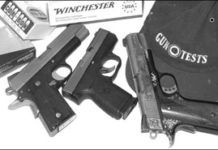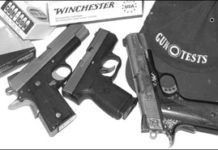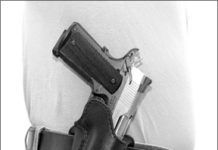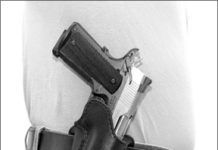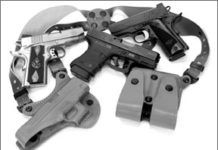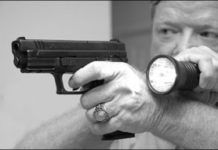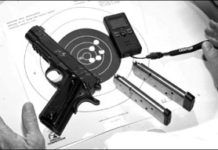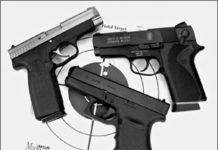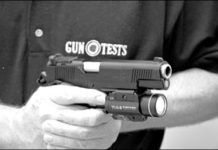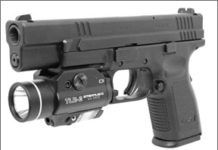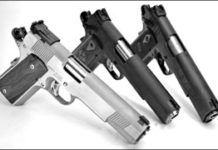Three Small 45 Autos: The New SIG Sauer 1911 C3 Is Superior
An the opinion of many experienced shooters, the 45 Auto is the caliber of choice in self-defensive pistols. However, most of these guns, like the classic 1911 Colt, are big and heavy. Therefore, they often get left behind for a lighter piece, which generally is of lower power. If you still want the power of a 45, why not go to a smaller and lighter gun?
We found three such pistols for this test, and gave them a wring-out. They were a Colt CCO, no longer in the Colt stable but available on the used or new-old-service market for about $1250, depending on condition; the recently introduced SIG Sauer 1911 C3 No. 19GS0031, $1143; and a new PM45-series pistol from Kahr, the PM4543, $855. The Kahr was not quite the same setup but clearly had the same intent as the other two, to deliver big power in a smaller, lighter package.
Both the SIG and Colt had aluminum frames, and they featured the old Colt Officer's Model handle with the Commander-length slide. Most of our test group believes this is the ideal setup for a 1911-type 45 auto, but those with large, wide hands might prefer a gun like the lightweight Commander, which has a bigger grip. The Kahr had its usual ergonomically designed polymer grip with stainless slide, and of course was DAO. We tested with three types of ammunition, Federal 185-grain Hi-Shok JHP, Federal 230-grain ball, and with Cor-Bon 185-grain JHP. We also tried a few groups with Federal Gold-Medal Match, 185-grain TC bullets. Here's what we found.
Three Small 45 Autos: The New SIG Sauer 1911 C3 Is Superior
An the opinion of many experienced shooters, the 45 Auto is the caliber of choice in self-defensive pistols. However, most of these guns, like the classic 1911 Colt, are big and heavy. Therefore, they often get left behind for a lighter piece, which generally is of lower power. If you still want the power of a 45, why not go to a smaller and lighter gun?
We found three such pistols for this test, and gave them a wring-out. They were a Colt CCO, no longer in the Colt stable but available on the used or new-old-service market for about $1250, depending on condition; the recently introduced SIG Sauer 1911 C3 No. 19GS0031, $1143; and a new PM45-series pistol from Kahr, the PM4543, $855. The Kahr was not quite the same setup but clearly had the same intent as the other two, to deliver big power in a smaller, lighter package.
Both the SIG and Colt had aluminum frames, and they featured the old Colt Officer's Model handle with the Commander-length slide. Most of our test group believes this is the ideal setup for a 1911-type 45 auto, but those with large, wide hands might prefer a gun like the lightweight Commander, which has a bigger grip. The Kahr had its usual ergonomically designed polymer grip with stainless slide, and of course was DAO. We tested with three types of ammunition, Federal 185-grain Hi-Shok JHP, Federal 230-grain ball, and with Cor-Bon 185-grain JHP. We also tried a few groups with Federal Gold-Medal Match, 185-grain TC bullets. Here's what we found.
Mixed Bag in Self Defense: Partner Handguns Fight It Out
Mixed Bag in Self Defense: Partner Handguns Fight It Out
Subcompact 45 ACPs: Glocks G30SF Makes It Look Easy
In this evaluation of 45 ACP subcompacts, we're going to ask how best to package the big bullet in a small concealable machine. We could say that our three test guns represent two-and-a-half interpretations of the subcompact pistol. That's because our first two pistols, Kimber's $1316 SIS Ultra and Springfield Armory's $1031 Loaded Ultra Compact, are both small single-stack 1911s. But there are differences that set them apart. The third gun feeds from a high-capacity magazine with rounds compressed in a staggered column. Furthermore, ignition is via a striker system, and the frame is polymer, not steel. This is the $687 Glock G30SF. If the price of the G30SF seems steep, that is because we ordered the gun with options such as night sights that added cost—but with the price of the Kimber and Springfield Armory pistols north of $1000, we had room to play around. Ultimately, we had a good representation of each manufacturer's smallest high-end 45.
Testing small guns is generally more challenging than testing full-size models. Big-frame guns may offer more than one suitable hand position. A small gun usually offers one grip position, like it or not. Consider the shorter sight radius. A 3-inch pistol may steer quicker than a 6-inch-barreled revolver, but any twitch of the little gun's front sight likely means the shooter will overcorrect.
Our first measure of accuracy was from sandbag support at 15 yards. With little framework to support these guns, our task was more difficult than mounting 5-inch-barrel Government models with longer dustcovers. Plus, a shorter slide means that its travel from battery to fully open provides less time to evacuate and recharge the chamber. We had to be careful not to let the slide touch any part of our support. This could slow the movement of the slide and cause a malfunction.
Our test ammunition was led by two defense rounds. They were Winchester's 185-grain Silvertip HP (hollowpoint) rounds and Federal's 165-grain expanding full metal jacket low-recoil ammunition. This round resembled a truncated cone (a triangle with the point cut off). With the price of ammunition soaring, we had intended to handload our practice ammunition. But we found that a 100-count box of quality jacketed bullets cost about the same as a 100-round box of loaded Winchester 230-grain FMJ ammunition purchased from Wal-Mart.
Loading lead bullets would have saved us money, but the polygonal barrel of the Glock, which once leaded greatly effects accuracy and is difficult to clean, repelled us from that option. We used the 230-grain ammunition in our action test, which consisted of standing and shooting a rapidfire string of seven continuous shots. Our target was the 4-inch bull of an 8.5-inch by 11-inch Caldwell paper target mounted 15 yards downrange.
Seven shots was the common denominator in terms of capacity between our three pistols, so we decided to count how many shots out of seven we could land on the notebook sized paper. This test was performed cold, picking up the gun and performing the drill one time only. Reliability, accuracy, ease of operation and concealment were our primary concerns in this test.
45 ACP Polymer Pistols with Thumb Safeties: Buy the XD45
.45 ACP Matchup: Were Mostly Sold on Kimbers Custom SIS RL
In this evaluation, we will look at three .45 ACP 1911-style pistols. Not too long ago, this would mean three pistols that looked almost exactly alike. But today's 1911 may contain as many different components as the total number of its parts. For example, the new Brownells catalog devoted solely to the 1911 lists as many as 27 different styles of custom hammers. Thus, our test guns offered several different variations on the 1911 platform.
Our three test guns were the $1421 Kimber Custom SIS RL, Springfield Armory's $1332 Loaded Operator MC, and the $1129 Para Ordnance P14-45S GR. Each gun fired from a 5-inch barrel supported at the muzzle by a bushing and could be referred to as full-size "Government" models. But the Para Ordnance pistol offered higher capacity, feeding from a wider magazine wherein the rounds were piled in a zigzag pattern rather than stacked in a single column. All three guns varied in the designs of their grips, sights, and thumb safeties.
Full-Size Polymer .45s: S&Ws M&P45 Beats H&K and Glock
Gun Tests readers sometimes ask why reviews on certain guns vary over time. For instance, they wonder why Gun A, reviewed two years ago, got a "Don't Buy" rating, but in a more recent evaluation, it gets a B+. The short answer is that test to test, guns vary, ammunition varies, the story angle varies, and, perhaps most important, the match-ups vary. In an earlier draw, Gun A may have run up against other models that made it look like chopped liver. Then when we tested it again, Gun A may have whipped Guns B and C because the latter two weren't much good, and Gun A benefited from the comparison.
In a way, that's what happened when we tested a new-for-2007 Smith & Wesson M&P 45 .45 ACP, $619, against a $1235 Heckler & Koch USP Compact Tactical USP45CT .45 ACP, which we last tested in June 2007, and the $635 Glock 21 SF, which we tested in July 2007. In June, the H&K got an "A" rating, when we said its "…light weight, ease of maintenance, and accuracy makes it very appealing. Our staff concluded that it was best to operate the USP45CT either as a full-time single-action pistol or a full-time TDA. Sticking with one system or the other was the only way to stay trained up, in our opinion."
Likewise, the Glock 21 SF got kudos from us as well, when we said in July, "No question this is an improvement on the G21. Better handling, but still a big gun with little potential for concealed carry. In our view, we think police will be trading in their G21s for the improved SF model."
First introduced by S&W in February 2007, the M&P45 is the newest addition to the M&P pistol series, a product line launched in December 2005. We've tested the M&P9 9mm and the M&P40 with varying degrees of success, rating the Smith & Wesson M&P 9mm Compact 2009004, $624, as a "D" in the April 2007 issue. The Smith & Wesson M&P .40 S&W No. 209000, $624, got a "Conditional Buy" in the August 2006 issue, and a Smith & Wesson M&P40 .40 S&W, $495, got an "A-" in the October 2007 issue.
The M&P45 began shipping in May 2007. Leland Nichols, president and COO of Smith & Wesson Corp., said at the time, "By combining the powerful .45 ACP cartridge with the performance and safety features of the M&P series, working professionals and shooting sports enthusiasts have a new option in the growing line of M&P products well-suited to fulfill a variety of needs."
Nichols continued, "We are also aware that multiple branches of the U.S. Military have expressed a desire to shift from their current 9mm weapons to either a .40 or .45 caliber duty weapon for greater stopping power. We are now currently shipping both .40 and .45 calibers, as well as a 9mm, in the M&P Pistol Series, and are fully prepared to address either requirement, should the U.S. Military initiate a request for purchase."
The gun was rolled out as a full-size polymer pistol with a 10+1 magazine capacity and an optional 14+1 magazine. It was originally offered with a traditional black frame and was manufactured with or without a frame-mounted ambidextrous thumb safety. Later, the M&P45 came with a dark earth-brown frame and a standard manual thumb safety, which is the gun we acquired for this test.
.45 ACP Single-Stack Pistols: S&W Pulls Out a Surprise Win
Full-Sized Tactical .45s With Accessory Rails: Buy the TRP
Versatile Polymer .45s: Two XD45 Compacts Are Our Picks
In this test we will look at four different polymer handguns that offer higher round capacity but take up less space than full-size models. Our first pistol, the $503 Taurus PT24/7 Pro 45-BP-12 could be considered a true compact, especially when compared to Taurus's new OSS pistol. The Springfield Armory XD45 4-inch Compact XD9645HCSP06, $589; and the Springfield Armory XD45 5-inch Compact Tactical XD9655HCSP06, $619, have undergone the Colt Officers treatment, receiving a shortened grip frame attached to a full-length slide. The $637 Glock SF21 is a remodeling of the Glock 21, but the SF21 does not seem to be much smaller. We wanted to find out if any of its subtle streamlining added up to a better pistol than the original.
We established basic accuracy for each pistol by measuring five-shot groups fired from a rest at 15 yards. Our test ammunition consisted of a typical practice round, Winchester's 230-grain FMJ Q4170 load and two hollowpoint defense rounds. Our JHP rounds were Winchester's USA45JHP ammunition and the Hornady Custom 185-grain JHP/XTP No. 9090 load. In terms of accuracy all three guns exceeded our expectations.
We also put the guns through an action-shooting test in which the operator pressed the trigger as fast as he could confirm an acceptable sight picture. For this test we visited American Shooting Centers in Houston (amshootcenters.com). There, we posted a Hoffners ABC16 target at the 7-yard line. This target measured a full 35 inches tall by 23 inches wide with six 3-inch aiming circles on each side of a humanoid silhouette. We fired 10 three-shot strings at the silhouette for a total of 30 rounds. The first two shots were aimed at the 5.5-by-8.0-inch A-zone chest area. The third shot was aimed at the B-zone, represented by a 5-inch-diameter half circle in the head. Firing from the bench at a 1.5-inch bull and unsupported at the Hoffners target were simple but revealing tests. Here is what we learned about each pistol.
































